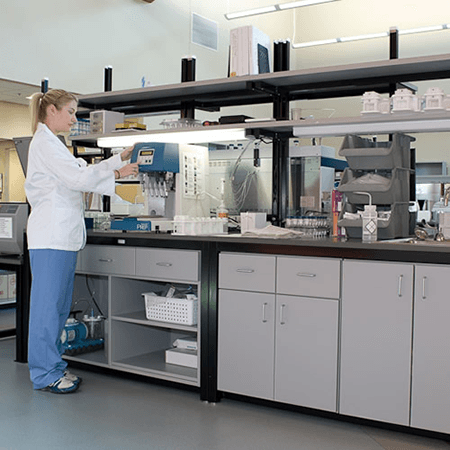Once considered a niche product, organic produce sales are on the march. Today’s health-conscious consumers are willing to pay a premium for the perceived quality benefits of organic foods, which are poised to grab additional market share as new industry players, such as Amazon with its acquisition of Whole Foods, enter the retail grocery market. The increasing demand is also driving the need for more organic produce testing by certified soil testing labs — a trend we heard loud and clear at Pittcon 2018.
As Consumer Taste for Organic Produce Grows, the Agricultural Revolution Shifts to Meet New Demand
As the saying goes, “If You Ate Today, Thank a Farmer.”
And indeed, we should. Since World War II, the Agricultural Revolution has spread around the world, allowing farmers to increase their production yields dramatically. Despite predictions to the contrary, modern agriculture is now able to feed a world with 7.6 billion hungry mouths.
But now, more and more consumers, particularly in western countries, are taking a closer look at the food we eat.
Studies show that an increasing number of consumers are considering organic produce purchases. Why? Many consumers now believe that organic produce is a superior, higher quality product.

Overall, American consumers are increasingly concerned. They are worried about the obesity epidemic in children, and the potential impacts of pesticide residues in our food supply. As a result, an increasing number of shoppers are educating themselves about what they eat. From “Eat Local” and “Farm–to–Table” campaigns that promote sustainable agriculture, to new food consumption trends such as “gluten-free” diets, and awareness of “GMO-Free” labeling, consumers are showing an increased awareness about where their food comes from and making new purchasing choices as a result.
Compared to American consumers, European consumers tend to be even more selective in their food consumption preferences. In fact, consumer protests by Europeans (who reject what are perceived of as “lax” American agricultural practices, such as using chlorine to process chicken and the introduction of GMO-based products) are widely credited for scuppering the long-standing TTIP trade negotiations between the US and Europe.
We haven’t seen the last of these controversies. Bayer’s pending acquisition of Monsanto, makers of the pesticide glyphosate (marketed as Roundup®), has reignited the row in Europe over pesticide usage in the food chain. Publicity surrounding the issue may ultimately drive increased preference for organic produce, both in Europe and here at home.
While an Increasing Number of American Consumers Prefer Organic Produce, Availability and Price Barriers Remain
While organic produce sales are way up, there are some constraints on future sales growth that need to be addressed.
The first issue is cost. Organic produce commands a premium price, which is due to a number of factors, including scarcity (organic farm production has not kept up with increasing demand).

While a Journal of Consumer Affairs study indicates that organic food consumers are willing to pay a price premium of 30% over conventional food products, spending additional money on food is not an easy option for disadvantaged/underprivileged households who are struggling to purchase groceries.
Purchasing organic produce is out of reach for lower-income households who must make difficult decisions between paying for medicine, rent, food, and other basic necessities.
The second issue that is limiting the mainstream adoption of organic food products is the issue of “Food Deserts”, which is the term that researchers use to describe neighborhoods (often underprivileged) that do not have green grocery stores nearby.
The food desert issue has become so critical that the Salvation Army is opening its first grocery store, in Baltimore, to address the issue.
As Distribution Channels Open Up, the Future of Organic Produce Farming Looks Bright
Market forces may be at work to solve the twin problems of high cost and limited availability.
“Buy Local” and “Farm-to-Table” campaigns are opening up new distribution channels, as consumers flock to local farmers markets. Consumers are also showing an interest in purchasing monthly allotments of produce (known as “shares”) directly from farmers.
But as romantic as the notion of buying organic produce directly from the farmer may be, it’s small potatoes (pardon the pun) when compared to the impact of Walmart’s grocery sales, which are estimated to account for 33% of US grocery retailing.
In 2006, Walmart began to offer organic produce in its grocery aisles. As the proverbial 800-pound gorilla in the room, there is no question that Walmart has broadened the distribution of organic produce across the nation. (According to Walmart, this is part of their overall strategy for sustainable agriculture.)
But wait! As of last year, we now have a 1,000-pound gorilla in the grocery retail market. Amazon’s purchase of Whole Foods appears to presage increased growth (and possibly lower prices) for Whole Foods’ organic produce moving forward.
Walmart is looking over their shoulder at the Amazon / Whole Foods duo. Meanwhile, the notoriously low-margin grocery retail business continues to see more turmoil, such as the recent bankruptcy restructuring of Southeastern Grocers, the parent company of Bi-Lo and Winn-Dixie, which is having to close 94 of its 582 stores.
The Shift to Organic Production Methods is Increasing Demand for Agricultural Soil Testing Labs
Despite the jockeying for position among top grocery retailers, the organic produce market seems poised for increased growth.
Among the beneficiaries from the increased demand for organic produce are agricultural soil testing labs, which will be asked to certify an increasing number of farms that are converting from conventional to organic farming practices.
This assessment seemed to be confirmed by the number of inquiries we received during our time exhibiting our lines of laboratory furniture at the laboratory science convention Pittcon 2018 recently held in Orlando, Florida.
Formaspace CEO Jeff Turk remarked that “while we have had a steady business from ag testing companies over the years, it was remarkable how many people came up to us during the exposition to talk about their plans to expand their laboratory operations to take on the certified organic soil testing business opportunity. This jump in demand for new or expanded soil testing laboratories mirrors the growth we are seeing for cannabis testing labs in those states which are permitting cannabis sales.”
One way to track the market is to look at research from ATTRA, an initiative of the National Center for Appropriate Technology (NCAT).
ATTRA, which receives much of its funding from the USDA’s Rural Business-Cooperative Service, keeps tabs on the locations of what it terms Alternative Soil Testing Laboratories for organic produce. Searching their database can help you understand the market need for soil testing in your region.
It bears repeating (as we mentioned at the beginning of this article), that “If You Ate Today, Thank a Farmer.”
Fortunately, there are signs that younger Millennials are heeding the call to work in sustainable agriculture, either in soil testing laboratories, in the fields, or in the distribution channel.
We need to encourage and appreciate their expertise, skill, and hard work that’s needed to keep feeding the world.
As a recipient of the 2014 North Carolina Small Farmer of the Year Award, Ryan Wiebe of Wiebe Farmin’ is an example of the commitment and expertise a new generation of farmers is bringing to the organic produce industry.
Formaspace is Your Agriculture Soil Testing Laboratory Partner
Are you interested in starting or expanding your laboratory operations in agriculture services? If so, we can help.
Formaspace can help you create an efficient soil testing lab for organic produce. Talk to your Friendly Formaspace Design Consultant today. Together, we can grow your lab business to its full potential.














